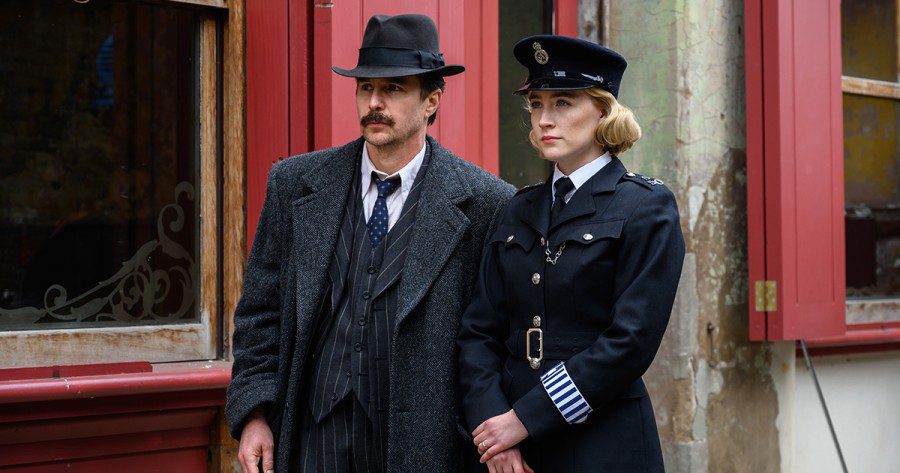Review: ‘See How They Run’ is a film that falters under its self-induced pressures
Starring Sam Rockwell and Saoirse Ronan, the comedic murder mystery film is now playing in select theaters.
Unlike other successful murder mystery movies, “See How They Run” falls short of the humor and clever plot twists. (Courtesy of Searchlight Pictures)
October 18, 2022
The murder mystery genre is a fairly cemented staple of literature, theater and film; this is in no small part due to Agatha Christie’s seminal works such as “Murder on the Orient Express,” “The A.B.C. Murders” and “The Mousetrap.” However, it also seems that the meta-mystery film has sprung out of the venerated genre and become its own beast entirely. Films like “Knives Out,” “Kiss Kiss Bang Bang” and “Clue” have all subverted the tried-and-true murder mystery archetypes while also poking fun at themselves and the genre as a whole. “See How They Run” overconfidently promises audiences the same witty humor and clever plot twists, but falls just short of the mark.
“See How They Run” follows jaded Inspector Stoppard (Sam Rockwell) and rookie Constable Stalker (Saoirse Ronan) as they investigate the murder of Leo Köpernick (Adrien Brody), a Hollywood film director who sets out to adapt Christie’s “The Mousetrap” for the big screen. Not to mention, the suspects are all actors, writers and producers involved in the hit play — how very meta. The film opens with a voiceover from Köpernick mocking all the tropes of murder mystery pictures. From the world-weary detective to the unsympathetic victim, Köpernick states, “If you’ve seen one, you’ve seen ‘em all.”
This new detective flick comes out swinging with this introduction, talking a big game about how it’ll set itself apart from other entries in the genre. However, this is only partly fulfilled by the end of the movie. In a sort of self-fulfilling prophecy, the film does feel different from other murder mysteries, but only because not many are this chock-full of references and gags alluding to other murder mysteries. Ultimately, “See How They Run” fails to meaningfully differentiate itself from other films of its genre.
If the whodunnit film genre wanted to live up to the expectations it set for itself, it would’ve cleverly subverted its plot points and characters from what viewers typically expect from a murder mystery. Unfortunately, that never quite happens. However, there’s still a colorful and entertaining roster of suspects, and the killer’s reveal will surely make those with a keen eye feel rewarded. All in all, it’s a solid murder mystery story. If not for its overconfidence in being set apart from other murder mysteries, the plot of “See How They Run” wouldn’t feel as underwhelming.
Thankfully, the visual style of “See How They Run” is anything but underwhelming. The film often utilizes exciting and snappy cinematography and editing. This breakneck visual pacing serves the film well when flashing through each suspects’ backstories. However, this style never feels overbearing, as the film balances it with more muted yet carefully considered shots and angles. This works especially well in the film’s wide angle shots of Stoppard and Stalker awkwardly discussing the case in their comically cramped car.
“See How They Run” also nails the look and feel of 1950s London. Both the set and costume designs really ground the viewer into the era. The film sometimes even emulates the antiquated cinematography of films from the `50s, further strengthening its sense of time and place.
The best part of the film by far is Ronan’s Stalker. The character’s clumsy eagerness, paired with Ronan’s impeccable comedic timing, ensures the film is entertaining throughout. Her awful puns and incessant note-taking provide “See How They Run” with some real nuggets of comedic gold. Stalker is also given an added layer of depth through her struggle to become a more respected and established part of the police force. As a result, her character becomes all the more endearing, making it impossible not to root for her.
Of course, Stalker is only half of the detective duo, the other being Rockwell’s Stoppard. Unfortunately, he never quite reaches the same heights as his clumsy companion. Many lines and gags throughout the film poke fun at the depressed detective archetype, which is all well and good.
However, Stoppard’s character never breaks any new ground with the trope. Rather than having the character overcome a personal struggle that puts him in a new light, much like Stalker, Stoppard remains pretty one-note. This is disappointing given that Rockwell is more than capable of giving a memorable performance, as showcased in “Vice,” “The Green Mile” and even “Jojo Rabbit.” Here, though, he isn’t given much to work with, and his performance feels rather passive and muted.
With a seemingly endless number of murder mystery stories to compete with, “See How They Run” tries hard to try and set itself apart. Regrettably, it’s a film with more bark than it has bite, as its plot doesn’t differ too greatly from its contemporaries it sets out to mock. Yet, it isn’t a complete miss — the film’s visuals are engaging, the characters are amusing and Ronan is an absolute joy to watch. “See How They Run” is a film that has a lot going for it, but fails to live up to its self-set goals.
Contact Ferris Elaraby at [email protected].
























































































































































